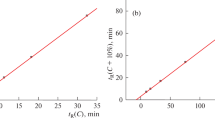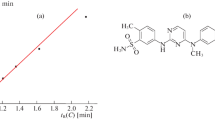Summary
An equation is derived which can describe how the retention of solutes is influenced by the composition of the mobile phase in reversed-phase liquid chromatography, the retention of solutes in alkyl bonded stationary phase regarded as the complexation between solute molecule and the active sites on the surface of the stationary phase. When the stationary phase is not fully saturated by the organic modifier, the activity of the active sites, the activity coefficient of the adsorbed solute as well as the activity coefficient of the solute in the mobile phase depend on the composition of the mobile phase. However, when the stationary phase is fully saturated, the composition of the mobile phase mainly influences the activity coefficient of the solute in the mobile phase. In addition, the selectivity of retention is discussed in terms of the derived equation.
Similar content being viewed by others

Abbreviations
- a:
-
adsorbed phase
- K:
-
thermodynamic equilibrium constant
- Kth :
-
thermodynamic distribution coefficient
- Ko :
-
distribution coefficient
- k′:
-
capacity factor
- L:
-
adsorption site or molar number of adsorption sites unoccupied by organic modifier
- Ltot :
-
total molar number of adsorption sites
- m:
-
mobile phase
- N:
-
molar fraction
- n:
-
number of adsorption sites occupied by a solute molecule
- n ms :
-
molar number of solvent in the mobile phase
- n mx :
-
molar number of solute in the mobile phase
- n axLn :
-
molar number of adsorbed solute
- s:
-
solvent
- Vm :
-
volume of the mobile phase
- \(\bar V_m \) :
-
average molar volume of the mobile phase
- W:
-
weight of the adsorbent
- x:
-
solute
- xLn:
-
complex of solute and adsorption site
- γ:
-
activity coefficient
- ϕ:
-
phase ratio
- Δ:
-
increment
References
Cs. Horváth, W. Melander, I. Molnár, J. Chromatogr.,125, 129 (1976).
B. L. Karger, J. R. Gant, A. Hartkopf, P. H. Weiner, J. Chromatogr.,128, 65 (1976).
R. Tijssen, H. A. H. Billiet, P. J. Schoenmakers, J. Chromatogr.,122, 185 (1976).
E. H. Slaats, J. C. Kraak, W. J. T. Brugman, H. Poppe, J. Chromatogr.,149, 255 (1978).
E. H. Slaats, S. Heemstra, H. Poppe, Dissertation, Amsterdam, Netherlands, 1980.
P. Jandera, H. Colin, G. Guiochon, Anal. Chem.54, 435 (1982).
D. E. Martire, R. E. Boehm, J. Phys. Chem.87, 1045 (1983).
P. L. Zhu, Chromatographia,20, 425 (1985).
R. M. McCormick, B. L. Karger, Anal. Chem.,52, 2249 (1980).
Author information
Authors and Affiliations
Rights and permissions
About this article
Cite this article
Zhu, P.L. On the chromatography mechanism of reversed-phase liquid chromatography. Chromatographia 21, 229–233 (1986). https://doi.org/10.1007/BF02311893
Received:
Accepted:
Issue Date:
DOI: https://doi.org/10.1007/BF02311893



